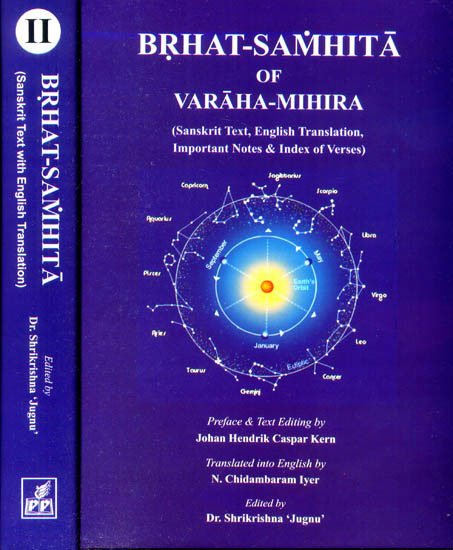Brihat Samhita
by N. Chidambaram Iyer | 1884 | 135,584 words | ISBN-13: 9788171104215
This is the English translation of the Brihat-samhita, one of the fundamental works of ancient Indian astronomy (known as Jyotisha). It was written in the 6th century A.D. (or 1st century B.C.) in about 4000 Sanskrit verses (slokas) by the polymath known as Varahamihira, who was considered as a great scientific scholar of mathematics, astronomy and...
End of Saṃhitā Proper (first half); Beginning of the second part
This brings us to the end of Saṃhitā Proper or the first half of Saṃhitā. In this part, over one thousand phenomena of Nature have been treated, each of which must have taken the ancient Hindus years of observation and tabulation. As these affect the well-being of humanity, a study of the same must be calculated to add to human happiness; most of the phenomena might appear improbable of occurrence, but it would be wrong, judging from our limited experience of Nature’s ways to say that she will never be caught playing this trick or that, or guilty of this freak or that. The solar spots is now an admitted fact. This was soon followed by a green sun. The mysterious noise heard recently in parts of Southern India is another instance of the kind. A few years ago it was reported in certain newspapers that in the District of Cornwall, England, there occurred a shower of flesh—vast fields being found literally covered with flesh several inches deep. More instances of the kind may be quoted. Indeed mysterious are the ways of Nature, and there is no saying what she may or she may not be capable of The present volume, therefore, becomes exceedingly interesting, as it embodies in a small compass a vast body of useful and curious information regarding the phenomena of Nature together with their effects and the means for removing the evils thereof.
The second part would be more interesting to the general public. A variety of interesting subjects are treated of in it. It would be well to state here briefly a few of such subjects
The Chapter on Puṣyasnāna treats of a particular bath for the king. This might as well be used by anybody else—the ingredients to be put into water containing evidently certain magnetic properties.
The Chapter on the Royal Sword contains certain methods for tempering cutting instruments.
The Chapter on Aṅga Vidyā relates to the interpretation of accidental gestures, movements, utterances and the like of man especially. It rests on the basis that an all-pervading universal Intelligence speaks in a thousand ways, and that it is for man to interpret such language and benefit himself by it. Scoffers will be least benefited by this chapter. Earnest enquirers after truth, by studying this branch of the science will be enabled to make pretty correct predictions.
The Chapter on Under-Currents is also an interesting one. The author proposes to discover the position, depth and course of undercurrents from the appearance of the ground above. The subject requires investigation. If there should he truth in the author’s statements, many of the tube-wells and boring instruments may be very well dispensed with.
Equally interesting is the chapter relating to the Plantation and Growth of Trees. According to the author, all seed trees can be made to grow like creepers by preparing the seeds in a particular way.
The subject of house building, and with it that of the preparation of strong cements, known las Vajralepana are also treated.
The author then treats of the features and other qualities of superior elephants, horses, dogs and the like. In this connection the subject of Sāmudrika, which relates to the determination of the fortunes of man from the marks and lines of his body and of which palmistry is a branch, is also treated.
The subject of the kind treatment of women is then taken up. Rules are also laid down for the preparation of scents and perfumes. A few lines are devoted to the subject of sexual love and of beds and cots.
The author then examines the qualities of superior diamonds, rubies, pearls and the like.
The subject of omens and prognostications is also treated.
The above is by no means an exhaustive list. While Part I is instructive, Part II is interesting.
[END OF PART-I]
